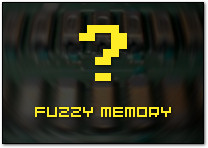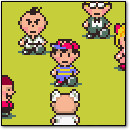Archive for the 'Computer History' Category
[ Fuzzy Memory ] Mainframe Games
Thursday, November 13th, 2008 It’s not every day that I receive a Fuzzy Memory dating back to the early days of personal computing. Come to think of it, it’s no every day that I receive a Fuzzy Memory. But I digress — in this case, the computer in question isn’t even personal, but a mainframe PDP 11/34. The year? 1979.
It’s not every day that I receive a Fuzzy Memory dating back to the early days of personal computing. Come to think of it, it’s no every day that I receive a Fuzzy Memory. But I digress — in this case, the computer in question isn’t even personal, but a mainframe PDP 11/34. The year? 1979.
Like always, I’m not an oracle of infinite knowledge and resources, so I need you (my adept readers) to help solve the mystery. And besides, I like making you do most of the work.
Advent, Trek, and Tripe
Robert wrote me a few days ago regarding a neolithic computer game from the disco era:
I have a new “fuzzy memory” search for you. When I first became addicted to computers in 1979, it was on a PDP 11/34 at my local college. That computer had 3 text-based games that endeared me to computers forever: Advent, Trek, and Tripe.
I have been able to find both Advent (which was the precursor to Zork) and Trek (a text-based Star Trek battle/strategy game). I have never tracked down a version of Tripe.
Tripe was a text-based parody of Star Trek. Key things that I recall about the game include:
- Away teams would raid a planet and “kill the women and rape the bad guys!”
- The ultimate weapon was the “dusn’t matter probe”. When fire, it would start playing one of Kirk’s famous speeches, at which point the enemy would commit suicide.
I don’t know if this game ever left the confines of the PDP, but it sure would be cool to track down a version of it.
Thanks,
Robert
The Search Begins
In this case, we’re fortunate: Robert knows the name of the game he’s looking for, and he knows the platform. But one key absence still prevents him from reliving his fondest gaming memories: the game itself. If anyone out there knows more about Tripe or how to obtain a copy of it, please let us know in the comments section. Perhaps there’s a more recent port of the game for another platform, or maybe someone has a disk image of the game that Robert could run on a PDP/11 emulator.
While you’re at it, feel free to leave your own mainframe memories in the comments below. Good luck!
—
Have a memory of a computer, video game, computer software, or electronic toy you need help identifying? Send me an email describing your memories in detail. Hopefully, the collective genius of the VC&G readership can help solve your mystery.
[ Retro Scan of the Week ] The TRS-80 Model 12
Monday, November 10th, 2008 (click for full advertisement)
(click for full advertisement)
I actually have a TRS-80 Model 12, although I don’t have a hard drive for it. I bought it at a flea market back in 2000-2001 for $20. It had been used for corporate accounting, payroll, spreadsheets, etc. for some years, and it came with a bunch of 8-inch disks and a huge dot-matrix printer. Sadly, the 8-inch drives on my unit both failed some years ago, although not before I got a chance to load up BASIC and tinker around with a spreadsheet. I haven’t gotten around to fixing them yet, but I’ll probably give it a shot some day.
Discussion topic of the week: Here’s a good one: How many of you readers out there have used systems with 8-inch floppy disks? If you have, tell us about the computer and your 8-inch floppy stories.
If you use this image on your site, please support “Retro Scan of the Week” by giving us obvious credit for the original scan and entry. Thanks.
Inside the Commodore 64
Wednesday, November 5th, 2008Yesterday, PC World published the latest in my “workbench” series of vintage tech autopsies. For its fifth installment, I dissected the immortal Commodore 64 while documenting the process in vivid color. This slideshow features some of my favorite vintage computer photos yet. I hope you enjoy it.
[ Retro Scan of the Week ] Satanic Printing Rites
Monday, October 27th, 2008 (click for full advertisement)
(click for full advertisement)
Since Friday is Halloween, I’ve pulled out this scary, 25 year-old ad from Interface Age. The Devil doesn’t look too happy with Qantex’s latest offering — the joke being that Qantex’s new model is compatible with Diablo printers. If any of you attend a costume party this Halloween, feel free to dress as the Qantex Devil. Be sure to take pictures.
Discussion topic of the week: Remember dot-matrix, impact, and daisy-wheel printers? How about thermal, bubble-jet, ink-jet, and laser? Tell us about your earliest printer experiences, good and bad.
If you use this image on your site, please support “Retro Scan of the Week” by giving us obvious credit for the original scan and entry. Thanks.
[ Fuzzy Memory ] The Unknown Apple Adventures
Saturday, October 25th, 2008 It’s been a while since we’ve had a Fuzzy Memory mysery to solve, but I recently received another request from someone seeking resolution of their distant gaming recollections. I’m not an oracle of infinite knowledge, so like always, I need the adept VC&G readership to help solve the mystery.
It’s been a while since we’ve had a Fuzzy Memory mysery to solve, but I recently received another request from someone seeking resolution of their distant gaming recollections. I’m not an oracle of infinite knowledge, so like always, I need the adept VC&G readership to help solve the mystery.
Adventures 7, 8, and 9?
Ryan wrote me a few days ago regarding a computer game from his past:
Many years ago my dad brought home a 5¼” floppy with the mysterious label “Adventures 7, 8, & 9” for our Apple IIGS. One side of the disk contained three text-based games. One took place in a carnival setting, one in the “old west,” and the other in an Egyptian pyramid.
My memories are very fuzzy, but I remember the gist of each adventure. For the carnival setting, one of the tasks that you had to do was chew some old gum, stick it on the end of a branch, and retrieve a key that was in a grate. In the old west setting, there were materials available to make gunpowder. There was also a horse called “Old Paint” that always bucked you off. The strangest thing about that one was that it got “dark” after several turns of play, and if you moved around in the dark at all, you had a very good chance of breaking your neck and the game would end.
Finally, all I remember about the pyramid setting was that there was some kind of strange portal you had to open – kind of an alien/pyramid weird combo theme thing. In any case, all three of these games were the classic “Go West,” “Get Key,” “Open Door” format and were very difficult for me at the time (of course, I was about 8 at the time, so I’d love to try my hand at them again if I just knew what they were).
The only other detail I can remember is that the reverse side of the disk had a “Planetoids” non-playable demo on it. I’m pretty certain the text-based game was developed for something before the Apple IIGS, but I’m just not sure. Any help would be greatly appreciated so I can solve this lifelong mystery!
Thanks very much in advance,
Ryan
His memories are quite detailed, which should be helpful. Also, the “Planetoids” clue is key — if that was a more high-profile Apple II game, then it should be easy to find its publisher. And the publisher of Planetoids was likely the publisher of the adventure games. I’ll let you guys do the rest.
The Search Begins
So what do you guys think? We need your help in identifying the game described above. If you have any ideas, please leave a comment on this post. The game is afoot!
—
Have a memory of a computer, video game, computer software, or electronic toy you need help identifying? Send me an email describing your memories in detail. Hopefully, the collective genius of the VC&G readership can help solve your mystery.
25 Years of Microsoft Word
Thursday, October 23rd, 2008 25 Years Ago this week, Microsoft released Microsoft Word 1.0 for MS-DOS and Xenix. To examine this anniversary, I wrote an article for PC World, which they published yesterday.
25 Years Ago this week, Microsoft released Microsoft Word 1.0 for MS-DOS and Xenix. To examine this anniversary, I wrote an article for PC World, which they published yesterday.
You’d think that Microsoft Word (of all things) would be a mundane topic to write about, but in fact, it was thoroughly interesting learning experience. Word hasn’t always been at the top of the word processor heap, and its origins in the murky depths of Microsoft Xenix are quirky, to say the least. Seemingly countless versions of Word have been released over the years, so I got to twiddle around with dozens of elderly versions of the world’s most popular word processing software.
My investigations into Word history also led me to enlightening conversations with ex-Xerox, ex-Microsoft, now-billionaire Charles Simonyi in Moscow (training for his second space tourist flight); Richard Brodie (gambler extraordinaire, author of Word 1.0); and Xenix guru Antoni Sawicki, who provided the Word for Xenix screenshot. Uncovering history from those who lived it is a fascinating and priceless experience, and it’s what keeps me coming back to write more history pieces every month. Stay tuned; there’s more on the way.
[ Retro Scan of the Week ] Interact Home Computer
Monday, October 13th, 2008 (click for full advertisement)
(click for full advertisement)
When I was compiling my list of the ten worst PC keyboards of all time last year, I considered many rare and obscure computers, like this Interact Model One. If I had included the Interact, it probably would have been high on the list. Among the original chiclet keyboard’s eccentricities is the fact that the number row starts with 2, counts up to 9, then 0, then finally reaches the number 1 (sort of like a really old typewriter whose lowercase “L” was used for “1,” but lacked a “1” key altogether.).
[ Continue reading [ Retro Scan of the Week ] Interact Home Computer » ]
[ Retro Scan of the Week ] Trapped in a Terminal Maze
Monday, September 29th, 2008 Somebody call the fire marshal.
Somebody call the fire marshal.
(Click above for full advertisement)
There’s nothing quite like the warm glow of a green screen terminal. I’ve never used a SWTPC terminal like those featured here, but I had a few DEC VT-125s with similar displays that I tinkered around with as a teenager. Now my terminal collection is larger, but there’s just something about that green phosphor CRT — maybe it’s a sentimental favorite of mine because I first learned to program BASIC on an Apple II+ with a green monochrome monitor. After that, amber- and white phosphor displays always seemed cold and impersonal by comparison.
Discussion topic of the week: Terminal Time! What’s the best terminal you’ve ever used? For those of you who never had to use dedicated terminals, tell us your favorite terminal emulation software.
If you use this image on your site, please support “Retro Scan of the Week” by giving us obvious credit for the original scan and entry. Thanks.
Apple I For Sale
Monday, September 15th, 2008

[ Update: 02/11/2010 – Rick Conte donated this Apple I to the Maine Personal Computer Museum in 2009 ]
It’s not every day that an original Apple I goes up for sale. In fact, it’s not every year that an Apple I goes up for sale. In case you didn’t know, the Apple I is an exceedingly rare machine.
 How rare? Well, various sources on the net say that about 200 units of Apple’s first computer were produced, and perhaps 30-50 survive to this day. To find out the truth behind these numbers, I checked with the designer of the Apple I himself, Steve Wozniak. But first, it’s time for a little history.
How rare? Well, various sources on the net say that about 200 units of Apple’s first computer were produced, and perhaps 30-50 survive to this day. To find out the truth behind these numbers, I checked with the designer of the Apple I himself, Steve Wozniak. But first, it’s time for a little history.
Apple co-founders Wozniak and Steve Jobs originally sold the Apple I for $666.66 (US) in 1976. With the help of friends, the duo built each and every Apple I by hand, although admittedly, there’s wasn’t much to the primitive machine. It shipped without an enclosure, keyboard, power supply, or display; the buyer was expected to furnish those parts. (Many people built them into briefcases, like the one seen here.)







